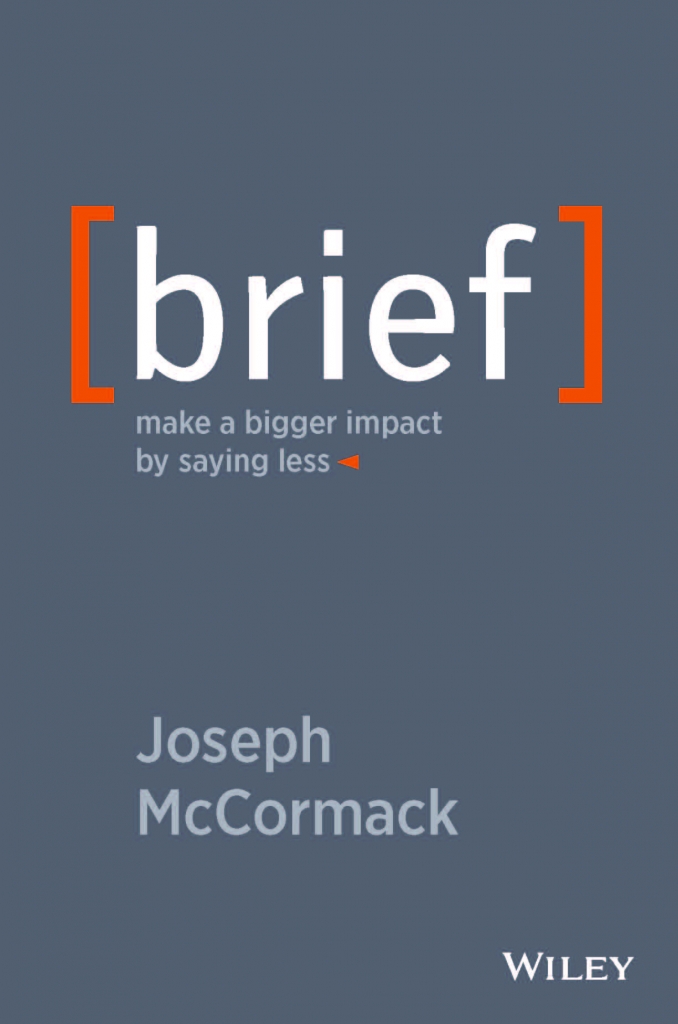There are immediate and real risks when you can’t get to the point in today’s attention-starved economy. Delayed decisions, ignored e-mails, endless meetings, harsh performance reviews, stalled sales and being avoided at all costs are among those consequences.
Brevity is emerging as a new business staple. Busy professionals expect it and get annoyed when it’s missing. In my new book Brief: Make a Bigger Impact by Saying Less, I outline the reasons why professionals struggle with brevity and how to embrace a “less is more” mentality.
Consider the growing hunger for people who know how to be clear and concise. Attention spans are in a tailspin. In 2000 the average length was 12 seconds, and now it’s only eight. Professionals are interrupted 6-7 times an hour, often unable to get back to the task at hand. The majority of people admit ignoring half of the e-mails they get every day, especially the complex and lengthy ones.
It’s not enough to be smart or have good ideas. Capturing and managing elusive mindshare now shape and define professional success. Even if your recommendation is brilliant and your update is buttoned up, you still lose out if you can’t consistently be brief. Shorter e-mails, more organized updates, and tighter presentations are immediate indicators that you’ve got what it takes to succeed in an attention economy.
Getting to the point is a non-negotiable standard. The reasons why people struggle with brevity are plentiful. In my experience, however, there are three common traps people fall into: they under prepare, over explain and simply miss the point completely.
People are afraid to take a stand, to be succinct and then be done. The temptation to say more, at times, can be too much for some people to handle. The next time you hear a client or colleague say, “And one more thing” you’ll know what I mean.
Ten years ago, brevity was a nicety and meant primarily for long-winded types that couldn’t shut up. Today, being clear and concise is an absolute necessity; it’s what successful people need to be mindful that their audience is mind-filled.
The mandate goes far beyond knowing the importance of brevity; it means the discipline of doing something about it.
Since raising your awareness isn’t enough, here are three things you can do to make an immediate, noticeable shift:
1. Take more time to prepare. It takes a concerted effort in advance to be brief. Write down your main point and three key ideas before you walk into your next meeting or jump onto the next conference call.
2. Respect that people’s time is precious. Their time is just as valuable as your own. When you sense you’re getting on a roll, it’s time to wrap it up.
3. Get to the point and let them talk. Be convinced that the people you communicate with are buried, that they want you to deliver the headline, and then let them react to it and tell you if they want to hear more. With a deeper sense of understanding you’ll trim information when others pile on.
Brevity is your professional responsibility. Though it may seem obvious, it really is hard work that requires constant vigilance and discipline. The payoff, however, is worth it when you, your ideas and your company clearly and quickly stand apart.
Posted On: 6/5/14
Joe McCormack is an experienced marketing executive, successful entrepreneur and author. He founded and serves as managing director of The Sheffield Company, an award-winning boutique agency recognized for its focus on narrative messaging and visual storytelling. His new book, Brief: Make a Bigger Impact by Saying Less (Wiley & Sons, 2014; http://amzn.to/1gA8hBw) tackles the timeliness of the “less is more” mandate. In 2013, he founded The BRIEF Lab (http://www.thebrieflab.com) as a specialty institute to help business and military leaders become lean communicators. There are currently facilities in Chicago, IL and Southern Pines, NC.














Leave A Comment
You must be logged in to post a comment.